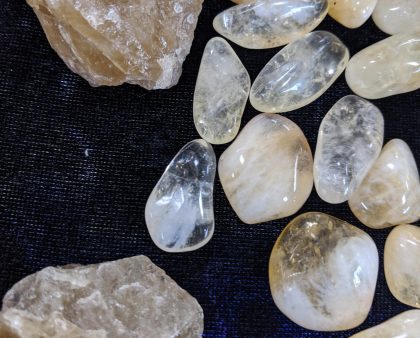The Geology
To fully understand the amazing stone that is Citrine, it’s necessary to understand the geology of it. In this blog post we’ll discuss the general geology of Citrine, where it’s mined, what dictates gemmy quality, and how it has been used historically.
The basic chemical compound of Citrine is SiO2 which stands for Silicon Dioxide. This is also known as Silica and is most commonly found in nature as sand or quartz. Represented in 3-D, its’ atoms would show each silicon atom bonded to 4 oxygen atoms. Don’t worry, I’m not going to far into the chemistry hole. However, if you are curious you can start your nerdy learning adventure on your own HERE . Citrine is typically transparent and because of that silica presence, it falls in the family of Quartz. It’s classified as vitreous which means that it has a glassy appearance and forms in a hexagonal system.
Citrine is a stone that falls at a hardness of 7 on the MOHS hardness scale. This means that it is harder than apatite but not nearly as tough as a diamond. Often Citrine itself is not a stone that is used in industrial manufacturing (think drill bits) but it’s close cousin clear Quartz can be found in many industries (most common is the electronics industry). There is likely some quartz contained within the device that you are reading this blog post on, but, more on that when we get to the quartz blog post 😊.
While Citrine is not used directly for tough jobs, it’s hardness does mean that the stone is tough enough to sustain normal wear and tear in jewelry like rings and bracelets, or even crowded with the other stones you have in your gem pouch without breaking and chipping easily. Basically, if Citrine were in your gemstone pouch with apatite and sapphire, the quartz would scratch up the apatite and probably break it, but the sapphire would crush the apatite and scratch up the Citrine.
Citrine comes in a range of colors between a light, almost indistinguishable yellow to a deep orange. Natural Citrine tends to run on the lighter end of the spectrum but is rare to find and makes it a true “gem” (pun intended). Because Citrine falls in the quartz family and is chemically close to Smoky Quartz and Amethyst, both stones are sometimes carefully heat treated to form what is often sold as Citrine on the open market.
It’s possible to find natural Citrine, it forms very close to amethyst pockets and often can be found in the same stone which is commonly known as Ametrine or as Phantom Citrine when formed close to Smoky Quartz. However, when you are choosing the piece of Citrine to go home with you, keep in mind that the shade of the Citrine can determine how it was formed and if it has undergone a heating process. The darker the color, the more likely that it has been heat treated from its close relatives Amethyst or Smoky Quartz.
All three of these stones get there colors from a presence of the element iron which can come from the stones hematite and goethite (geology blog). Technically, what is truly defined as a “natural” Citrine is a transparent yellow and will sometimes contain crackling, sparkles, or even rainbows within the inclusions when rotated under light (like the picture above).
The name of Citrine comes from the word Citron. A fun fact is that no matter what country, the term citron is the same word in many cultures for lemon. In old-world Greece for example, it was referred to as Lemon Quartz, Bohemian Topaz, Citron, and Kundalini Quartz. 
Speaking of locations, Citrine is harvested all over the globe! Brazil is leading the way in producing natural citrine, but it’s also mined in the United States, Argentina, Madagascar, and Namibia to name a few.
Historically, Citrine was often mistaken for Golden Topaz because of the paleness of the stone and if a large enough piece was found it was carved into handles for swords and daggers. It has always been associated with affluence (more to come on this Friday).
Stop by Crystal Spirit today to snag a piece of Citrine for your collection. We have Phantom Citrine points, natural stumbled stones in the tower of tumbled stones, and we even have a batch of the most amazing raw natural Citrine chunks; all sustainably sourced.
That’s it for the geology of Citrine! Check back on Friday where we will dig into the esoteric and metaphysical properties of the stone Citrine. Until then Crystal Lovers!



